University Nursing Practice Reflection on Medication Administration
VerifiedAdded on 2023/01/17
|5
|1140
|93
Journal and Reflective Writing
AI Summary
This assignment is a reflective journal by a nursing student detailing four clinical scenarios involving medication administration. The student reflects on challenges encountered, such as setting up infusion pumps, calculating drug dosages, and preparing intravenous medications. Key skills gaps identified include the use of infusion pumps, dosage calculation for different administration methods, and mixing different concentrations of medications. The student outlines plans for improvement, including training on infusion pumps and drug dosage calculation, aligning with NMBA standards. The reflection emphasizes the importance of continuous professional development to ensure patient safety and compliance with evidence-based guidelines. The scenarios highlight the risks associated with intravenous medications and the need for nurses to have adequate knowledge and skills in medication administration to prevent errors. References to relevant literature support the importance of training and skill development in safe nursing practice.
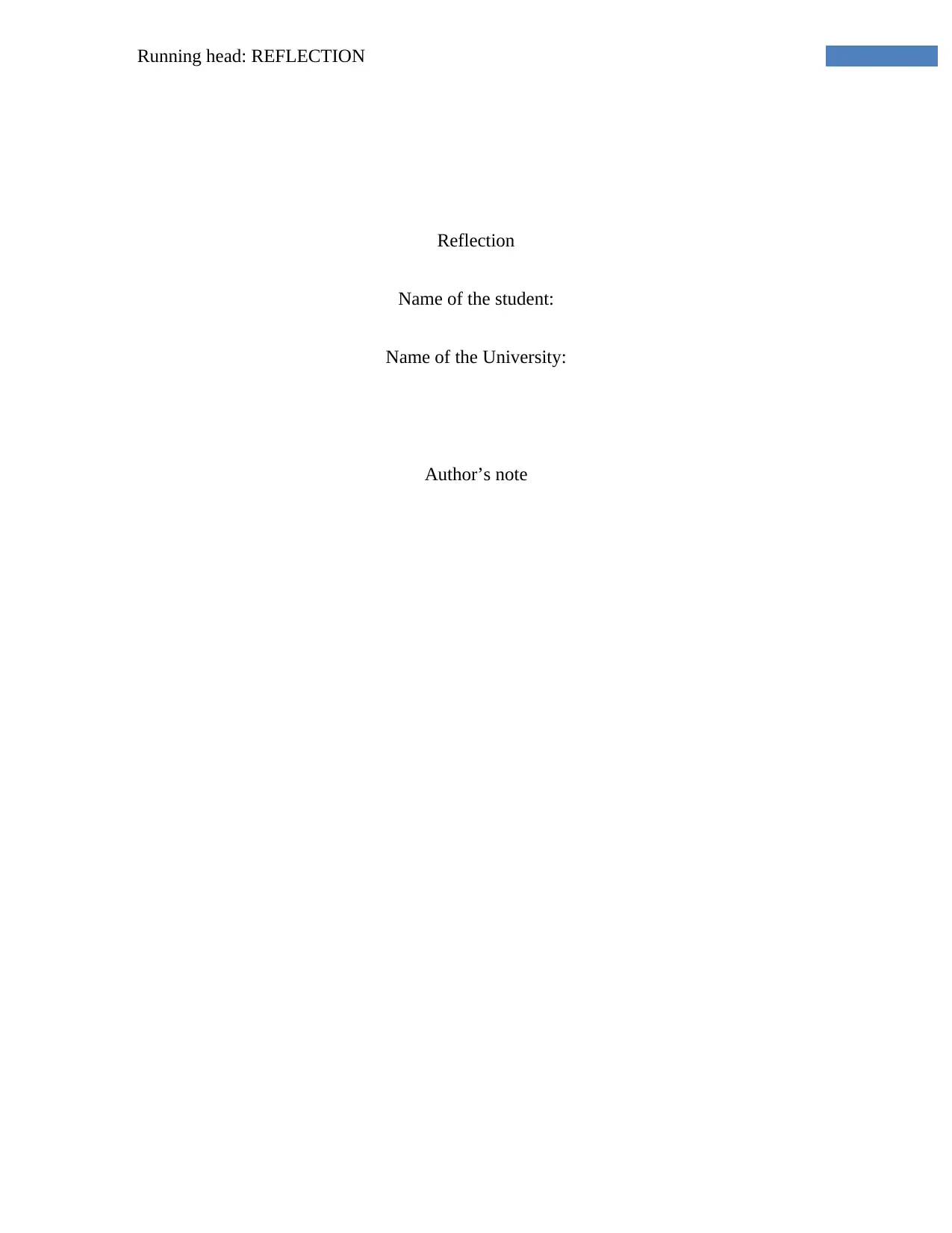
Running head: REFLECTION
Reflection
Name of the student:
Name of the University:
Author’s note
Reflection
Name of the student:
Name of the University:
Author’s note
Paraphrase This Document
Need a fresh take? Get an instant paraphrase of this document with our AI Paraphraser
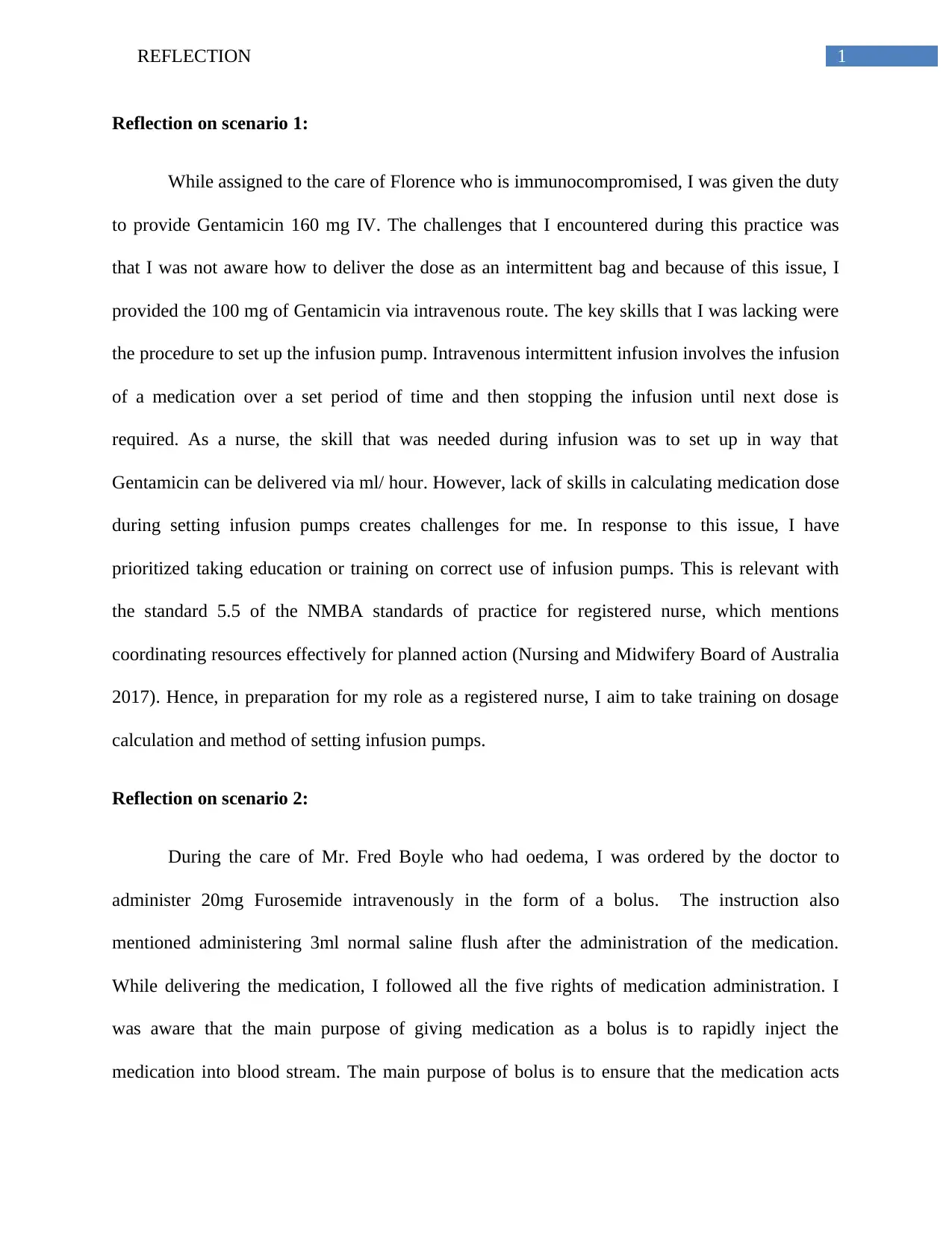
1REFLECTION
Reflection on scenario 1:
While assigned to the care of Florence who is immunocompromised, I was given the duty
to provide Gentamicin 160 mg IV. The challenges that I encountered during this practice was
that I was not aware how to deliver the dose as an intermittent bag and because of this issue, I
provided the 100 mg of Gentamicin via intravenous route. The key skills that I was lacking were
the procedure to set up the infusion pump. Intravenous intermittent infusion involves the infusion
of a medication over a set period of time and then stopping the infusion until next dose is
required. As a nurse, the skill that was needed during infusion was to set up in way that
Gentamicin can be delivered via ml/ hour. However, lack of skills in calculating medication dose
during setting infusion pumps creates challenges for me. In response to this issue, I have
prioritized taking education or training on correct use of infusion pumps. This is relevant with
the standard 5.5 of the NMBA standards of practice for registered nurse, which mentions
coordinating resources effectively for planned action (Nursing and Midwifery Board of Australia
2017). Hence, in preparation for my role as a registered nurse, I aim to take training on dosage
calculation and method of setting infusion pumps.
Reflection on scenario 2:
During the care of Mr. Fred Boyle who had oedema, I was ordered by the doctor to
administer 20mg Furosemide intravenously in the form of a bolus. The instruction also
mentioned administering 3ml normal saline flush after the administration of the medication.
While delivering the medication, I followed all the five rights of medication administration. I
was aware that the main purpose of giving medication as a bolus is to rapidly inject the
medication into blood stream. The main purpose of bolus is to ensure that the medication acts
Reflection on scenario 1:
While assigned to the care of Florence who is immunocompromised, I was given the duty
to provide Gentamicin 160 mg IV. The challenges that I encountered during this practice was
that I was not aware how to deliver the dose as an intermittent bag and because of this issue, I
provided the 100 mg of Gentamicin via intravenous route. The key skills that I was lacking were
the procedure to set up the infusion pump. Intravenous intermittent infusion involves the infusion
of a medication over a set period of time and then stopping the infusion until next dose is
required. As a nurse, the skill that was needed during infusion was to set up in way that
Gentamicin can be delivered via ml/ hour. However, lack of skills in calculating medication dose
during setting infusion pumps creates challenges for me. In response to this issue, I have
prioritized taking education or training on correct use of infusion pumps. This is relevant with
the standard 5.5 of the NMBA standards of practice for registered nurse, which mentions
coordinating resources effectively for planned action (Nursing and Midwifery Board of Australia
2017). Hence, in preparation for my role as a registered nurse, I aim to take training on dosage
calculation and method of setting infusion pumps.
Reflection on scenario 2:
During the care of Mr. Fred Boyle who had oedema, I was ordered by the doctor to
administer 20mg Furosemide intravenously in the form of a bolus. The instruction also
mentioned administering 3ml normal saline flush after the administration of the medication.
While delivering the medication, I followed all the five rights of medication administration. I
was aware that the main purpose of giving medication as a bolus is to rapidly inject the
medication into blood stream. The main purpose of bolus is to ensure that the medication acts
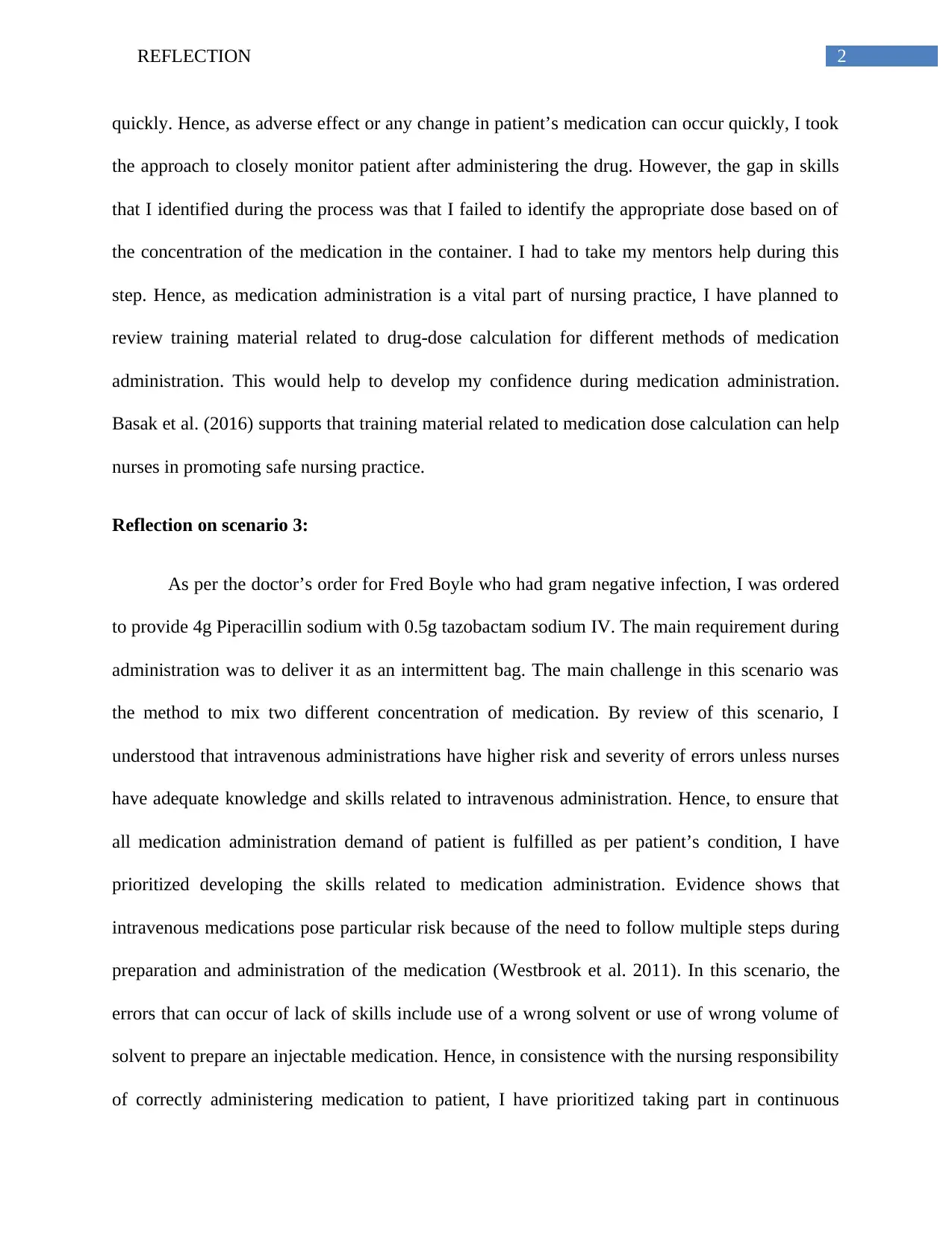
2REFLECTION
quickly. Hence, as adverse effect or any change in patient’s medication can occur quickly, I took
the approach to closely monitor patient after administering the drug. However, the gap in skills
that I identified during the process was that I failed to identify the appropriate dose based on of
the concentration of the medication in the container. I had to take my mentors help during this
step. Hence, as medication administration is a vital part of nursing practice, I have planned to
review training material related to drug-dose calculation for different methods of medication
administration. This would help to develop my confidence during medication administration.
Basak et al. (2016) supports that training material related to medication dose calculation can help
nurses in promoting safe nursing practice.
Reflection on scenario 3:
As per the doctor’s order for Fred Boyle who had gram negative infection, I was ordered
to provide 4g Piperacillin sodium with 0.5g tazobactam sodium IV. The main requirement during
administration was to deliver it as an intermittent bag. The main challenge in this scenario was
the method to mix two different concentration of medication. By review of this scenario, I
understood that intravenous administrations have higher risk and severity of errors unless nurses
have adequate knowledge and skills related to intravenous administration. Hence, to ensure that
all medication administration demand of patient is fulfilled as per patient’s condition, I have
prioritized developing the skills related to medication administration. Evidence shows that
intravenous medications pose particular risk because of the need to follow multiple steps during
preparation and administration of the medication (Westbrook et al. 2011). In this scenario, the
errors that can occur of lack of skills include use of a wrong solvent or use of wrong volume of
solvent to prepare an injectable medication. Hence, in consistence with the nursing responsibility
of correctly administering medication to patient, I have prioritized taking part in continuous
quickly. Hence, as adverse effect or any change in patient’s medication can occur quickly, I took
the approach to closely monitor patient after administering the drug. However, the gap in skills
that I identified during the process was that I failed to identify the appropriate dose based on of
the concentration of the medication in the container. I had to take my mentors help during this
step. Hence, as medication administration is a vital part of nursing practice, I have planned to
review training material related to drug-dose calculation for different methods of medication
administration. This would help to develop my confidence during medication administration.
Basak et al. (2016) supports that training material related to medication dose calculation can help
nurses in promoting safe nursing practice.
Reflection on scenario 3:
As per the doctor’s order for Fred Boyle who had gram negative infection, I was ordered
to provide 4g Piperacillin sodium with 0.5g tazobactam sodium IV. The main requirement during
administration was to deliver it as an intermittent bag. The main challenge in this scenario was
the method to mix two different concentration of medication. By review of this scenario, I
understood that intravenous administrations have higher risk and severity of errors unless nurses
have adequate knowledge and skills related to intravenous administration. Hence, to ensure that
all medication administration demand of patient is fulfilled as per patient’s condition, I have
prioritized developing the skills related to medication administration. Evidence shows that
intravenous medications pose particular risk because of the need to follow multiple steps during
preparation and administration of the medication (Westbrook et al. 2011). In this scenario, the
errors that can occur of lack of skills include use of a wrong solvent or use of wrong volume of
solvent to prepare an injectable medication. Hence, in consistence with the nursing responsibility
of correctly administering medication to patient, I have prioritized taking part in continuous
⊘ This is a preview!⊘
Do you want full access?
Subscribe today to unlock all pages.

Trusted by 1+ million students worldwide
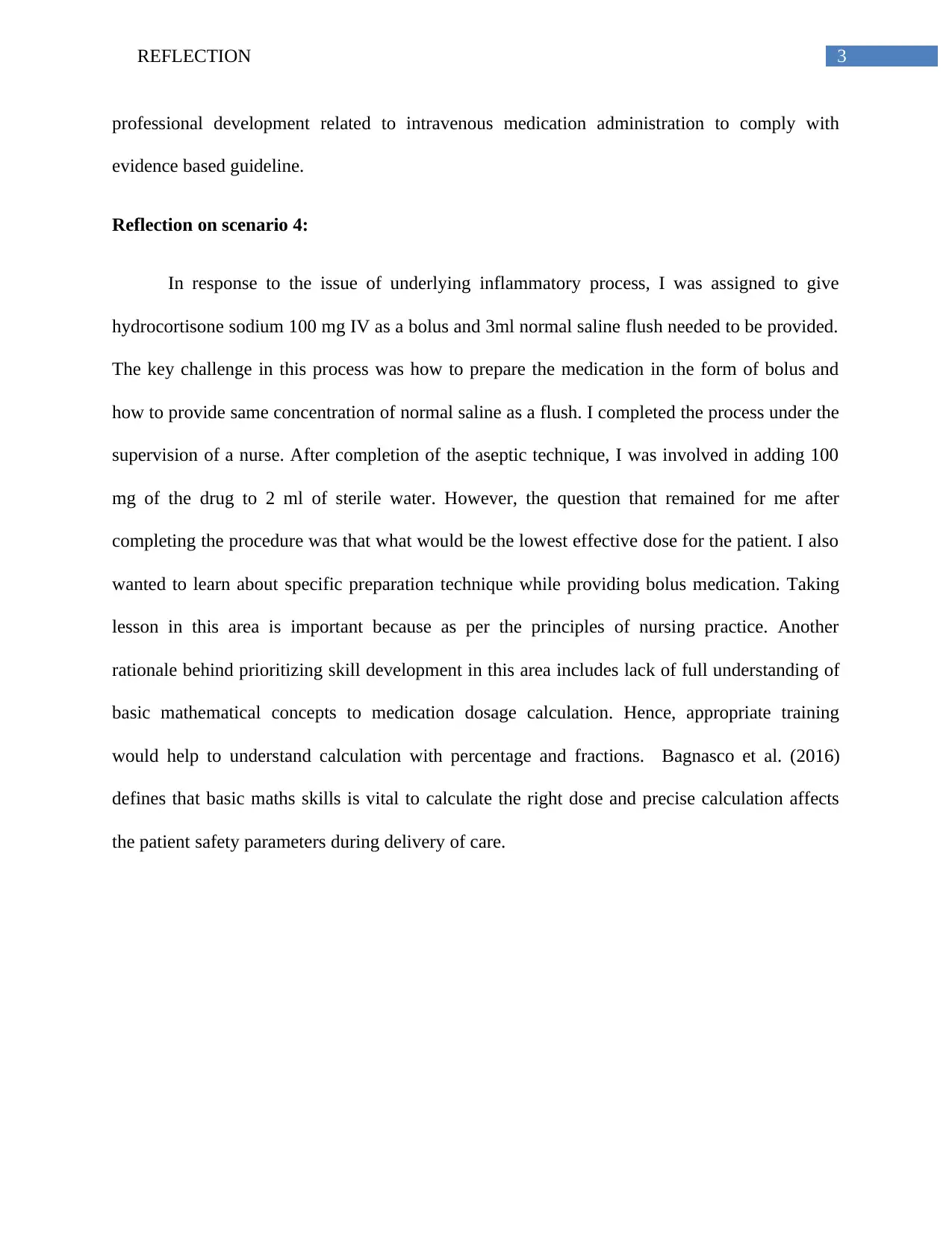
3REFLECTION
professional development related to intravenous medication administration to comply with
evidence based guideline.
Reflection on scenario 4:
In response to the issue of underlying inflammatory process, I was assigned to give
hydrocortisone sodium 100 mg IV as a bolus and 3ml normal saline flush needed to be provided.
The key challenge in this process was how to prepare the medication in the form of bolus and
how to provide same concentration of normal saline as a flush. I completed the process under the
supervision of a nurse. After completion of the aseptic technique, I was involved in adding 100
mg of the drug to 2 ml of sterile water. However, the question that remained for me after
completing the procedure was that what would be the lowest effective dose for the patient. I also
wanted to learn about specific preparation technique while providing bolus medication. Taking
lesson in this area is important because as per the principles of nursing practice. Another
rationale behind prioritizing skill development in this area includes lack of full understanding of
basic mathematical concepts to medication dosage calculation. Hence, appropriate training
would help to understand calculation with percentage and fractions. Bagnasco et al. (2016)
defines that basic maths skills is vital to calculate the right dose and precise calculation affects
the patient safety parameters during delivery of care.
professional development related to intravenous medication administration to comply with
evidence based guideline.
Reflection on scenario 4:
In response to the issue of underlying inflammatory process, I was assigned to give
hydrocortisone sodium 100 mg IV as a bolus and 3ml normal saline flush needed to be provided.
The key challenge in this process was how to prepare the medication in the form of bolus and
how to provide same concentration of normal saline as a flush. I completed the process under the
supervision of a nurse. After completion of the aseptic technique, I was involved in adding 100
mg of the drug to 2 ml of sterile water. However, the question that remained for me after
completing the procedure was that what would be the lowest effective dose for the patient. I also
wanted to learn about specific preparation technique while providing bolus medication. Taking
lesson in this area is important because as per the principles of nursing practice. Another
rationale behind prioritizing skill development in this area includes lack of full understanding of
basic mathematical concepts to medication dosage calculation. Hence, appropriate training
would help to understand calculation with percentage and fractions. Bagnasco et al. (2016)
defines that basic maths skills is vital to calculate the right dose and precise calculation affects
the patient safety parameters during delivery of care.
Paraphrase This Document
Need a fresh take? Get an instant paraphrase of this document with our AI Paraphraser
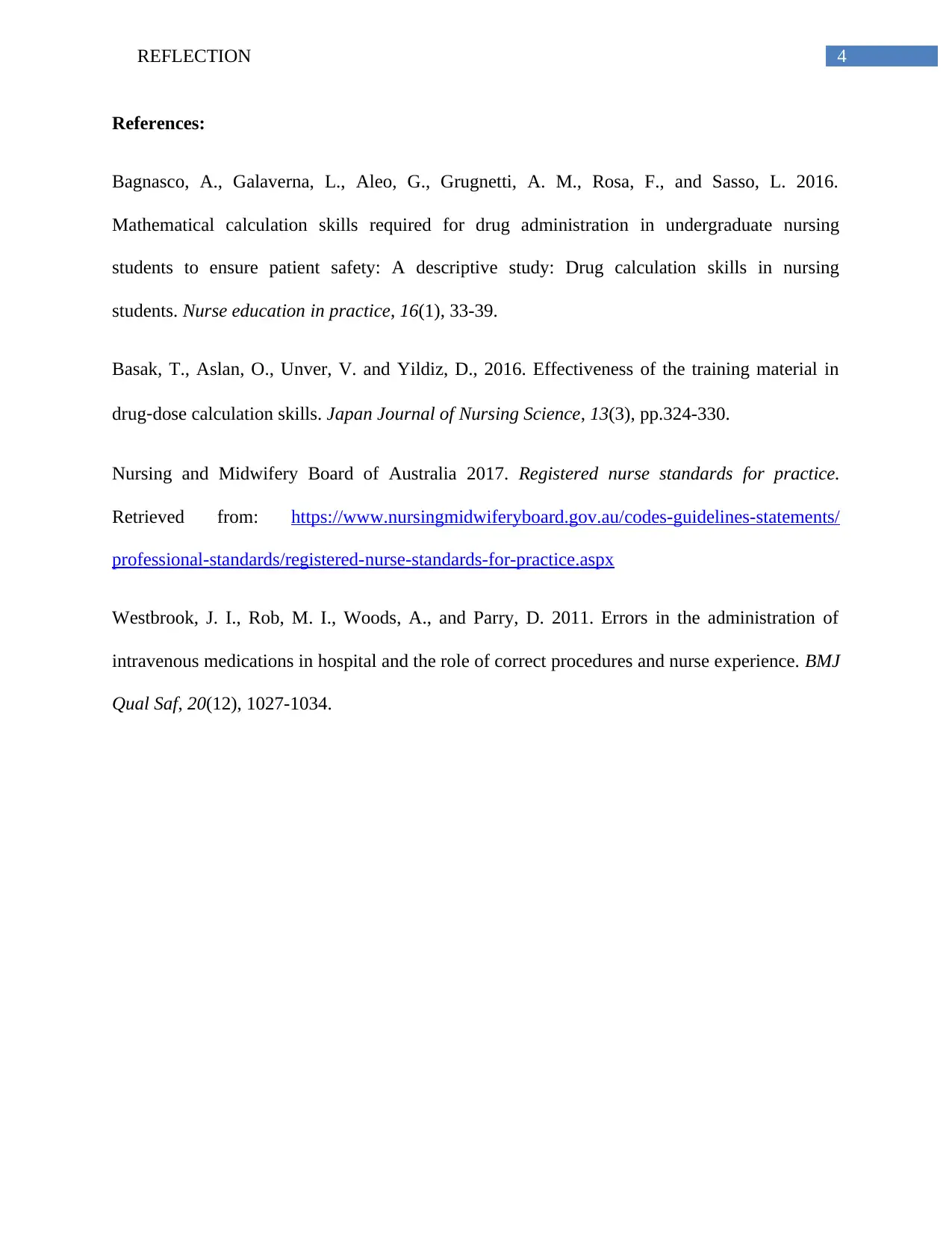
4REFLECTION
References:
Bagnasco, A., Galaverna, L., Aleo, G., Grugnetti, A. M., Rosa, F., and Sasso, L. 2016.
Mathematical calculation skills required for drug administration in undergraduate nursing
students to ensure patient safety: A descriptive study: Drug calculation skills in nursing
students. Nurse education in practice, 16(1), 33-39.
Basak, T., Aslan, O., Unver, V. and Yildiz, D., 2016. Effectiveness of the training material in
drug‐dose calculation skills. Japan Journal of Nursing Science, 13(3), pp.324-330.
Nursing and Midwifery Board of Australia 2017. Registered nurse standards for practice.
Retrieved from: https://www.nursingmidwiferyboard.gov.au/codes-guidelines-statements/
professional-standards/registered-nurse-standards-for-practice.aspx
Westbrook, J. I., Rob, M. I., Woods, A., and Parry, D. 2011. Errors in the administration of
intravenous medications in hospital and the role of correct procedures and nurse experience. BMJ
Qual Saf, 20(12), 1027-1034.
References:
Bagnasco, A., Galaverna, L., Aleo, G., Grugnetti, A. M., Rosa, F., and Sasso, L. 2016.
Mathematical calculation skills required for drug administration in undergraduate nursing
students to ensure patient safety: A descriptive study: Drug calculation skills in nursing
students. Nurse education in practice, 16(1), 33-39.
Basak, T., Aslan, O., Unver, V. and Yildiz, D., 2016. Effectiveness of the training material in
drug‐dose calculation skills. Japan Journal of Nursing Science, 13(3), pp.324-330.
Nursing and Midwifery Board of Australia 2017. Registered nurse standards for practice.
Retrieved from: https://www.nursingmidwiferyboard.gov.au/codes-guidelines-statements/
professional-standards/registered-nurse-standards-for-practice.aspx
Westbrook, J. I., Rob, M. I., Woods, A., and Parry, D. 2011. Errors in the administration of
intravenous medications in hospital and the role of correct procedures and nurse experience. BMJ
Qual Saf, 20(12), 1027-1034.
1 out of 5
Your All-in-One AI-Powered Toolkit for Academic Success.
+13062052269
info@desklib.com
Available 24*7 on WhatsApp / Email
![[object Object]](/_next/static/media/star-bottom.7253800d.svg)
Unlock your academic potential
Copyright © 2020–2025 A2Z Services. All Rights Reserved. Developed and managed by ZUCOL.


